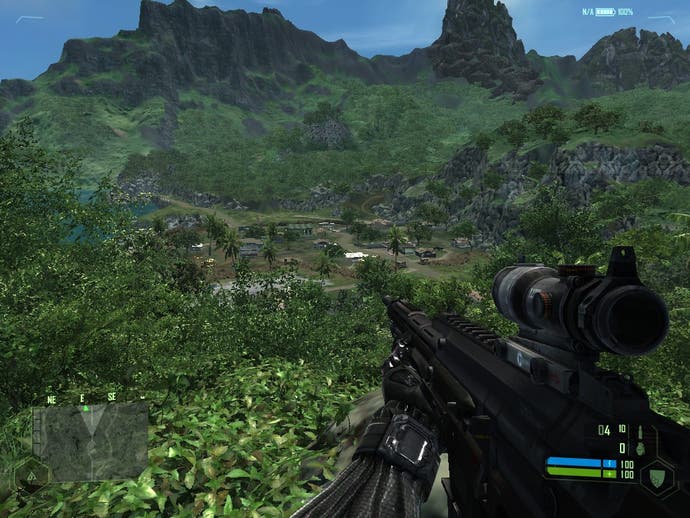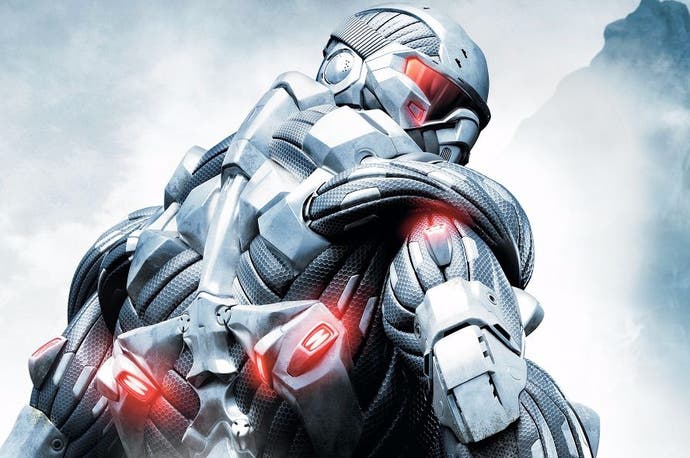Revisiting Crysis, the last great bastion of PC elitism
Maximum hubris.
All hail Crysis, the "Maximum Game". How odd it feels to revisit this legendary mass-melter of motherboards, this bane of frame rates and comparison threads, on what passes for a budget gaming laptop 10 years down the line. The intro especially rouses much the same sense of everlasting absurdity and pathos you might get from Hadrian's Wall or a Microsoft Zune, an orgiastic showreel in which bullets flatten themselves against quivering artificial muscles, and North Korean troopers gape at all the high-octane graphicsability coruscating around them as they're hurled headlong into their friends. Once upon a time, you think to yourself, we called this the future. Alas, futures seldom age that gracefully.
Crytek owes its existence to its knack for such glitzy spectacle - the company's breakthrough project was a dinosaur wilderness sim named X-Isle in 2000, a piece of graphics card benchmarking software that became the basis for the original Far Cry. Nowhere is that inheritance more evident than in Crysis, a moderately open-ended cybernetic shooter whose omni-capable Nanosuit armour is a bulging, flexing metaphor for its own technical achievement. At a time when browser and mobile games were the fashion and blockbuster PC exclusives were on the wane, Crysis was a bastion of hope for custom hardware junkies. To run it back in 2007 was to join a proud club of macho super-consumers, to straddle the cutting edge with cowboy hat in hand while filthy casuals and the less affluent made do with caveman fare like Call of Duty 4. The Warhead expansion leans into this crude stratification of player culture by purchasing power explicitly, with graphics options that range from "Mainstream" to "Gamer" - no prizes for guessing which is the higher setting.
To play Crysis today is to remember that selling your art on the strength of its supporting tech is essentially writing the epitaph on the back of the box, though the game is still very handsome, with sprawling draw distances and sun rays fizzling through restless foliage. Beyond the odd smeary rock texture or, say, the absence of an animated transition when you collar a guard, it's that addled fixation with Operating at the Max that dates it the most. There are still plenty of technophiles around and lest I sound too much like the sneering hipster I undoubtedly am, there's nothing wrong with preferring a higher resolution or a faster frame rate, but PC gaming has come to be celebrated for its diversity and conceptual ambition rather than brute power. The idea of sticking it to the PlayStationistas with some hardcore anti-aliasing now seems deeply comic, like trying to restart the War of the Roses by egging a chipshop in Manchester.
Why, then, return to Crysis? One answer is that while many sandbox shooters echo its flexible balance of stealth, resilience and rapid movement, few manage this balance as elegantly and entertainingly. For all the spittle-frothed talk of adaptive polymers and hydrothrusters, the game's smartest touch is a homely energy bar, shared by all of your Nanosuit's abilities. The bar drains quickly - three or four super-jumps or a few seconds at warp-speed will empty it out - but refills almost as fast, and the result is a brisk little feedback loop of risk and reward, as you work out how much you can pull off in that window versus some pleasantly responsive soldier AI. You might speed through tall grass to a house, pause for a couple of seconds to catch your breath, jump onto the roof, cloak, line up a couple of headshots, then use the last 20 per cent of suit juice to zip sideways into the cover of a boulder, even as grenades fly towards the house, killing everybody inside. The Nanosuit is sold to you as the wrath of god, a hulking embodiment of the hardware required to run the game, but that ferocity belies the extent to which you'll be exposed and vulnerable if you push it too far, and the interplay is handled with a flair that is genuinely a thrill to rediscover. You can't buy Nanosuit performance like you can a faster GPU - it's all about what you do with what you're given.

The Nanosuit is also eerie and unsettling in ways I'm not sure Crytek itself ever appreciated. While creeping around the game's fictitious South Pacific archipelago, I was struck by the thought that I was playing a horror story from the perspective of the monster. Imagine being one of the grunts unlucky enough to see service on Lingshan Island - gazing out over a lush stretch of rainforest and glimpsing far off, in amongst the sun shafts and palm fronds, an oily metal silhouette that immediately vanishes. You raise your rifle and step forward, calling out to your team, but it is already too late, as a shimmer at your elbow solidifies into something coiled and merciless and not quite of this world. It cuts down the men to your left and right and slithers back into the scenery, only to reappear seconds later, striking at the rear.
The specific horror parallel is 1987's Predator, another tacit Vietnam War story in which a group of American alpha warriors are plunged into a no-win scenario featuring aliens, active camo and infra-red vision. Predator is a useful comparison because it illustrates what a powerful, troubling work of emergent drama Crytek might have woven had it treated the Nanosuit not as a sleek gizmo, but a psychological construct against which technology offers little defence. Nowadays, of course, the Predator itself isn't exactly an object of mystery: as with the Xenomorph, the creature has been swaddled in backstory to the point that it feels positively staid, its capabilities grounded in a discourse of future-science. But think about how it first appears in the film, a menacing watchfulness dispersed through wide shots of hanging vegetation or palls of smoke that is exactly as ghastly as you imagine it to be.
Long before you lay eyes on the Predator you're shown the world through its eyes, a depthless tangle of blue shadows in which the musclebound cast are reduced to leaky, meandering blotches of yellow and red, given away by their own vital systems, helpless for all their explosive hardware. Far from suggesting a hunter's precision, as with the Crysis equivalent, the Predator's thermal scope is a means of estrangement and confusion, making the crowded, cloying jungle feel still more oppressive. As per well-established monster movie practice, it assumes a more definite form as the story unfolds, but even after it enters the realm of the visible, there's the sense that the creature is only mirroring its prey, developing exaggerated masculine traits in response to their over-compensatory virility. It's the male gaze made flesh and turned against itself. Perhaps the film's finest sequence shows the Predator descending into the fiery wreckage of a camp after Arnie and co's departure, playing back tinny recordings that slowly clarify into soldier's voices, before reaching across the view with a shockingly human hand.

At times, the same shock is palpable on the faces of soldiers in Crysis, that pop-eyed revulsion as the forest comes alive and wraps its fingers around their throats, but for the most part enemies react to your presence, visible or invisible, only with anger. They have Nanosuits of their own, after all, and bigger problems in the shape of a mountain full of centuries-old, murderous alien squid. Finally unleashed in the campaign's second half, the Ceph are worth battling for their ability to alter the climate - beating a retreat through areas that have been frozen solid is a great lategame payoff, and another show of Crytek's technical chops - but they're otherwise a conventional species of monstrosity, the kind of tentacular bogeymen we've been fighting in video games for decades. It doesn't help that their arrival also marks the point when Crysis stops being a sandbox and starts being a shooter about escort missions and chase sequences.
The annoying thing about the Nanosuit is that Crytek latched onto some of its latent dramatic potential in hindsight. In Crysis 2 the suit is revealed to be the product of Ceph science, and the plot sees your protagonist slowly merging with the device as it physically grows into his injuries, a queasy prospect that sets a few worthwhile trains of thought in motion - what precisely constitutes the human or selfhood in the age of cyborgs, and whether there is two-way traffic between player and avatar in video games, the extent to which we are changed by the virtual entities under our control. The premise never really comes to anything save a few heartfelt soliloquies, however, and was overshadowed by Crytek's efforts to court the "mainstream" consumers it had previously disdained, much to the ire of its existing fanbase. A stripped-back city adventure aimed at players with shorter attention spans, Crysis 2 was arguably the series' death knell - the threequel found a little more favour but in the wake of Titanfall, Destiny and Call of Duty: Advanced Warfare, each larded to the gills with cyborg appliances, the Maximum Game has been forgotten. All things considered, I'm happy to let it lie.










